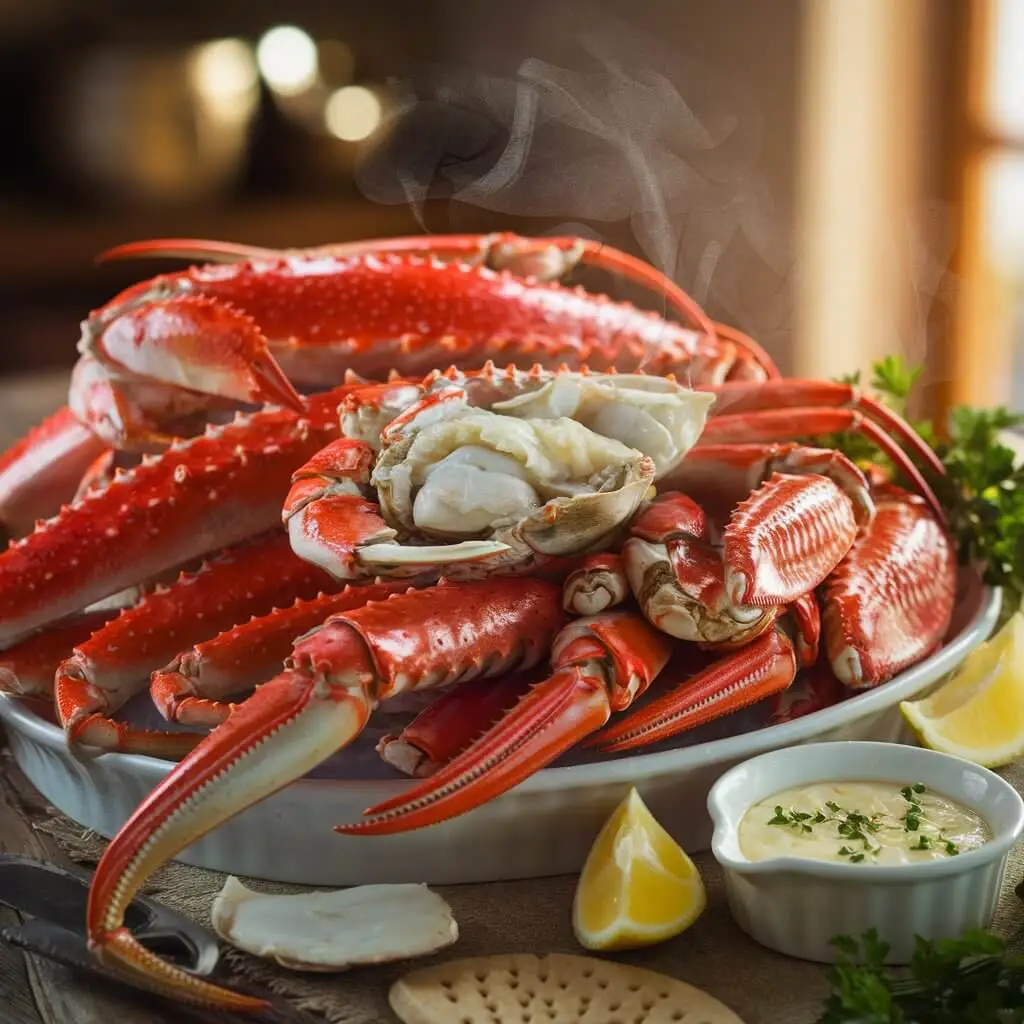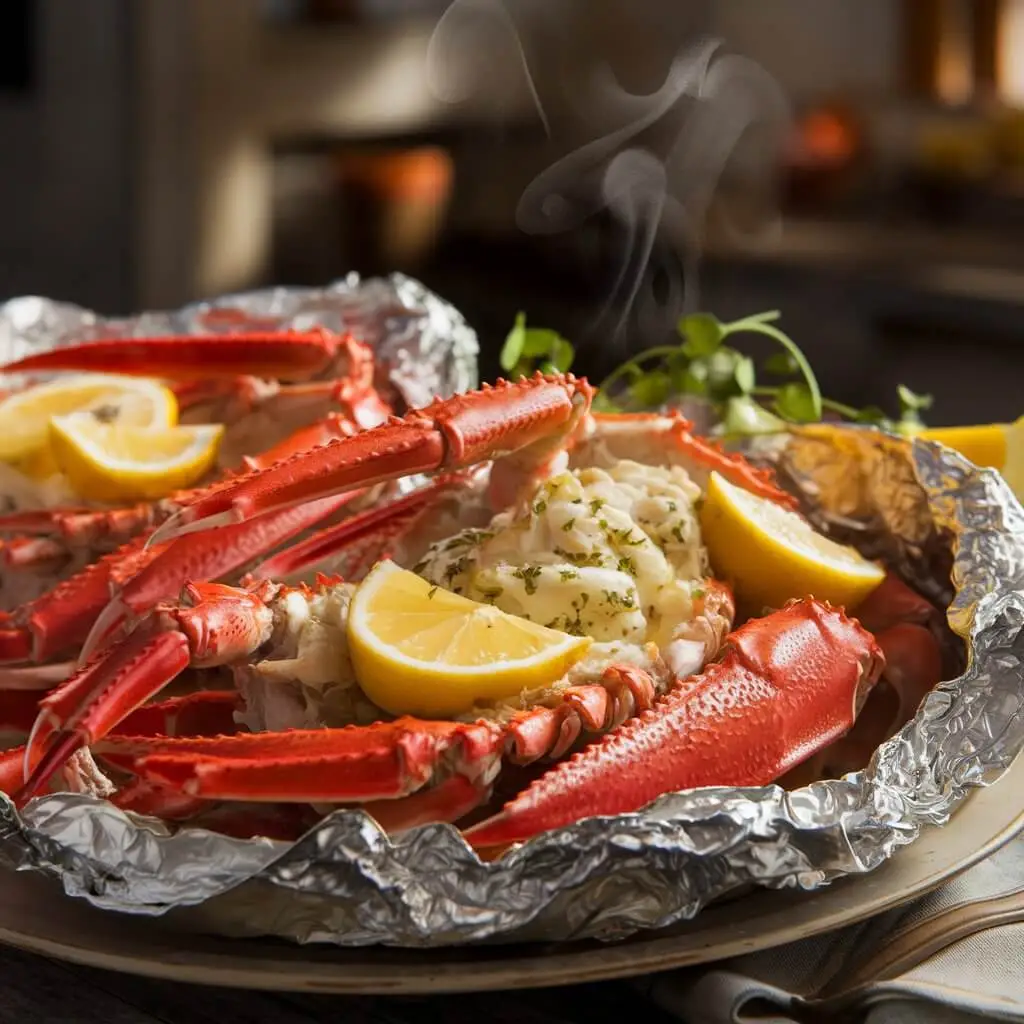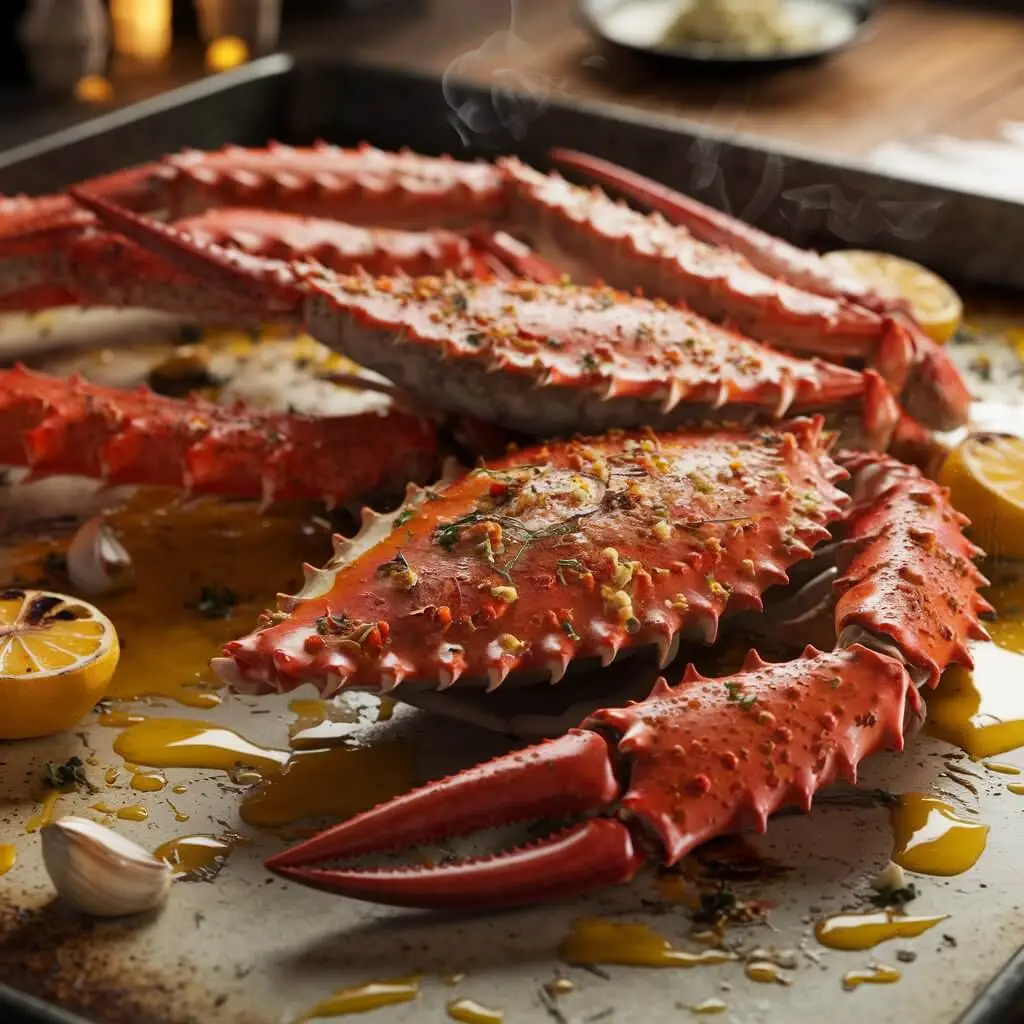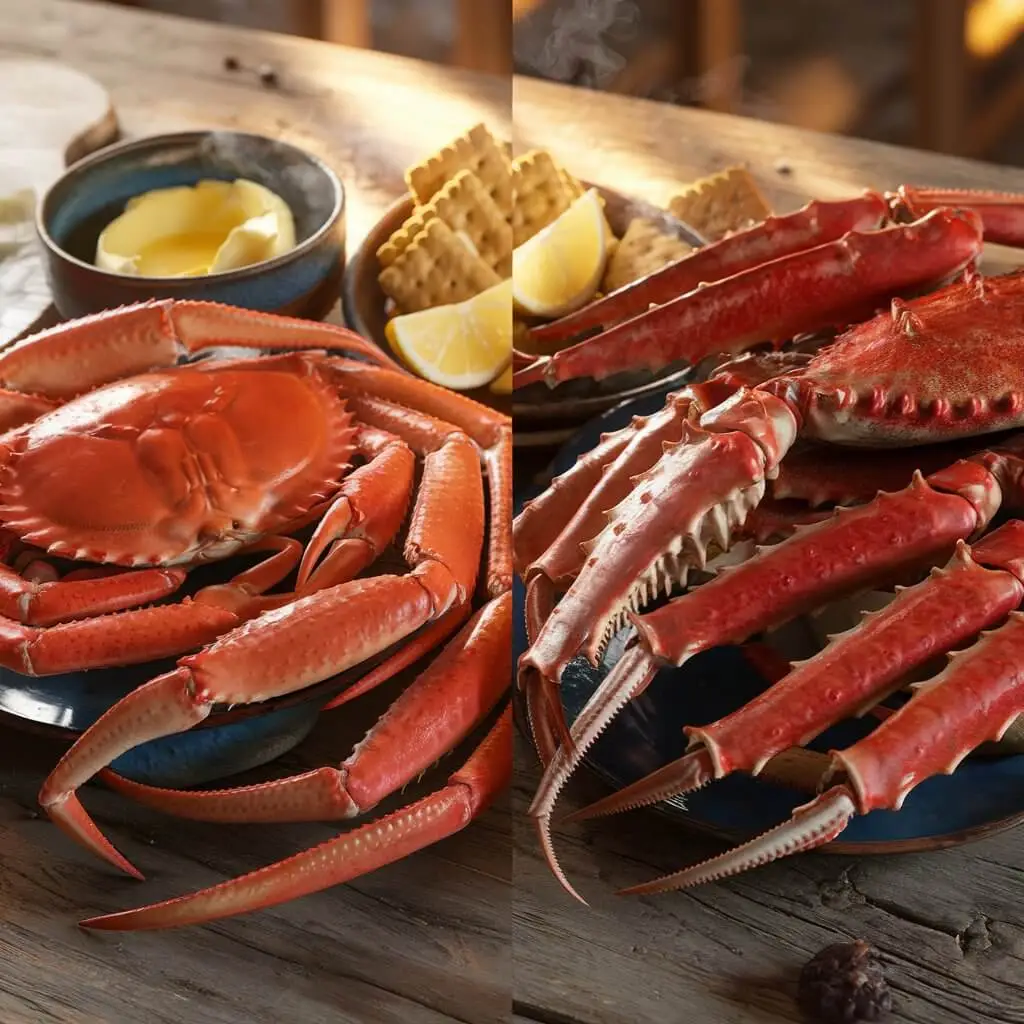Crab legs are a beloved seafood delicacy, but when it comes to choosing between snow crab legs and king crab legs, many seafood lovers find themselves wondering which one is the better choice. Both types of crab are known for their sweet, succulent meat, but they differ significantly in size, texture, flavor, price, and availability. While snow crab legs are more affordable and widely available, king crab legs are considered a premium seafood option, offering thick, meaty portions with a rich, buttery taste.
If you’ve ever debated between ordering snow crab legs or king crab legs at a restaurant or buying them from a seafood market, this guide will help you make an informed decision. We’ll break down the differences in size, taste, texture, cooking methods, cost, and sustainability so you can choose the best crab legs for your next seafood feast. Whether you’re looking for a budget-friendly option for a seafood boil or a luxurious dining experience with premium crab meat, understanding the key characteristics of each type will help you pick the right one.
Let’s dive into the ultimate comparison of snow crab legs vs. king crab legs and find out which one is the perfect fit for your seafood cravings!
Understanding Snow Crab Legs and King Crab Legs
When it comes to choosing between snow crab legs and king crab legs, understanding their origins, characteristics, and species differences can help you make the right choice. Below, we break down everything you need to know about these two popular types of crab.
What Are Snow Crab Legs?
Snow crabs (Chionoecetes opilio) are a species of crab found in the cold waters of the North Atlantic and North Pacific Oceans, primarily in the Bering Sea and the Gulf of Alaska. They are well-known for their long, slender legs, which are typically sold in clusters.
- Size & Appearance: Snow crabs are smaller compared to king crabs, with legs that are thinner and more flexible. Their shells have a light brown hue with an orange tinge.
- Texture: The meat inside snow crab legs is firm yet delicate, with a slightly shredded texture, making it easy to pull apart.
- Flavor: Snow crab meat has a sweet, briny taste that is slightly milder than king crab.
- Where They Are Found: Snow crabs are caught in deep, cold waters, with major fishing areas in Alaska, Canada, and Russia.
- Seasonal Availability: The snow crab season typically runs from January through April, making them widely available during this time.
What Are King Crab Legs?
King crabs (Paralithodes camtschaticus), particularly Red King Crabs, are one of the most sought-after seafood delicacies. These crabs thrive in the icy waters of the North Pacific, especially around Alaska, Russia, and the Bering Sea.
- Size & Appearance: King crabs are massive in size, with thick, spiny legs. A single leg can be much larger than an entire cluster of snow crab legs.
- Texture: The meat is tender yet dense, with large chunks that have a satisfying bite.
- Flavor: King crab meat is rich, buttery, and sweet, often considered a delicacy due to its succulent texture.
- Where They Are Found: King crabs are caught primarily in Alaska’s frigid waters, with major fishing grounds in the Bering Sea and Norton Sound.
- Seasonal Availability: King crab season is short, typically running from October to early January, making it a more premium and expensive choice.
Key Differences in Crab Species
Understanding the main differences between snow crabs and king crabs helps seafood lovers choose the right type based on price, taste, and texture.
| Feature | Snow Crab Legs | King Crab Legs |
|---|---|---|
| Scientific Name | Chionoecetes opilio | Paralithodes camtschaticus |
| Size | Smaller, thinner legs | Large, thick, spiny legs |
| Texture | Firm, slightly shredded | Tender, chunky, and rich |
| Flavor | Sweet and briny | Sweet, buttery, and delicate |
| Shell Hardness | Thin, easy to crack | Thick, requires tools to crack |
| Fishing Location | North Atlantic, North Pacific, Bering Sea | Alaska, Russia, Bering Sea |
| Price Range | More affordable | Expensive, premium seafood |
Both types of crab offer unique flavors and textures, making them popular among seafood lovers. While snow crab legs are more accessible and budget-friendly, king crab legs are a luxurious choice, often reserved for special occasions.
Table of Contents
Size, Texture, and Flavor Comparison
One of the biggest differences between snow crab legs and king crab legs is their size, texture, and flavor. These factors play a key role in deciding which crab suits your taste preferences and cooking needs.
How Big Are Snow Crab Legs vs. King Crab Legs?
Size is a major distinguishing factor between these two crab types. King crab legs are significantly larger and thicker than snow crab legs, making them the preferred choice for those looking for meaty, substantial seafood dishes.
Snow Crab Leg Size:
- Snow crabs are smaller in size, with long and slender legs.
- The average snow crab weighs between 1.5 to 3 pounds, and its legs are relatively thin and elongated.
- When sold in seafood markets, snow crab legs are typically available in clusters of four legs and a claw, making them easier to portion and serve.
- Each leg contains less meat per shell compared to king crab, but since they are sold in clusters, they provide a good amount of seafood per serving.
King Crab Leg Size:
- King crabs are much larger, with thick, robust legs.
- A fully grown king crab can weigh between 6 to 10 pounds, with some reaching up to 15 pounds or more.
- King crab legs are sold individually, rather than in clusters, because of their larger size and weight.
- One king crab leg can often contain more meat than an entire snow crab cluster, making them a premium choice for seafood lovers.
Size Comparison Chart:
| Feature | Snow Crab Legs | King Crab Legs |
|---|---|---|
| Leg Size | Thin and long | Thick and meaty |
| Average Crab Weight | 1.5 – 3 lbs | 6 – 10+ lbs |
| Meat per Leg | Less meat per leg | High meat-to-shell ratio |
| Sold As | Clusters (4 legs + claw) | Individual legs |
Texture and Shell Thickness
Another major difference between these two crab varieties is their shell thickness and meat texture. If you’re planning to prepare and eat crab at home, knowing which one is easier to crack open can save time and effort.
Snow Crab Shell and Meat Texture:
- Snow crabs have a thinner, more flexible shell, which makes them easier to crack open by hand or with basic seafood crackers.
- The meat inside is delicate and slightly fibrous, similar to lobster or white fish.
- Because of its shredded texture, snow crab meat is ideal for salads, pastas, and seafood casseroles.
- The shells tend to snap easily, and diners can often pull out large chunks of meat with minimal effort.
King Crab Shell and Meat Texture:
- King crabs have a thick, hard, spiny shell, making them more difficult to crack open. Specialized seafood tools, such as crab crackers or kitchen shears, are often needed.
- The meat inside is firmer, chunkier, and more substantial, offering large, juicy bites.
- The texture is buttery and tender, making it perfect for grilled dishes, seafood platters, and gourmet preparations.
- Because of the thicker shell and more substantial meat, king crab legs offer a luxurious dining experience that feels heartier than snow crab.
Shell & Texture Comparison Chart:
| Feature | Snow Crab Legs | King Crab Legs |
|---|---|---|
| Shell Thickness | Thin, easy to crack | Thick, requires crab crackers |
| Ease of Eating | Can be cracked by hand | Requires tools |
| Meat Texture | Soft, slightly shredded | Firm, chunky, substantial |
| Best For | Salads, pastas, casseroles | Grilled dishes, seafood platters |
Flavor Profile of Each Crab Type
When it comes to taste, both snow crab and king crab are highly sought after, but they have distinct flavor differences that can influence your choice.
Snow Crab Flavor:
- Snow crab has a mildly sweet, slightly briny taste.
- The flavor is lighter and less rich compared to king crab, making it a great option for dishes where the crab is mixed with other ingredients.
- The sweetness of the meat is enhanced when dipped in butter or lemon sauce.
- Because snow crab meat has a slightly shredded texture, it blends well into soups, pastas, and seafood boils.
King Crab Flavor:
- King crab is known for its rich, buttery, and naturally sweet taste.
- The flavor is more intense and decadent, making it the preferred choice for seafood lovers looking for a gourmet experience.
- The meat is often served with melted butter, garlic sauce, or Cajun spices to enhance its natural sweetness.
- Because king crab legs contain larger chunks of meat, they are often served as a main dish rather than an ingredient in mixed dishes.
Flavor Comparison Chart:
| Feature | Snow Crab Legs | King Crab Legs |
|---|---|---|
| Flavor Profile | Mildly sweet, slightly briny | Rich, buttery, intensely sweet |
| Best Flavor Pairings | Butter, lemon, garlic | Butter, garlic, Cajun spices |
| Meat Use | Mixed in dishes | Served as the main feature |
Final Thoughts on Size, Texture, and Flavor
- If you prefer a milder, more delicate seafood option, snow crab legs are a great choice. They are easier to eat, budget-friendly, and ideal for salads, pastas, and seafood boils.
- If you’re looking for a rich, buttery, and luxurious seafood experience, king crab legs are the way to go. They offer thicker, meatier portions that feel indulgent and satisfying.
- For casual seafood lovers or those looking for a cost-effective option, snow crab is the better pick.
- For special occasions, fine dining, or a gourmet seafood feast, king crab is the superior choice.
Cooking and Serving Snow Crab vs. King Crab
When it comes to preparing and serving snow crab legs vs. king crab legs, each type has its best cooking methods, ideal flavor pairings, and cracking techniques. Below, we’ll explore the different ways to prepare these delicious crab legs and make the most of their unique textures and flavors.
Best Ways to Cook Snow Crab Legs

Snow crab legs are versatile and easy to cook, making them a favorite for home chefs and seafood lovers alike. Since they have a thin, delicate shell, they require minimal preparation before cooking. Most snow crab legs sold in stores are pre-cooked and frozen, meaning you only need to reheat them rather than cook them from scratch.
Steaming Snow Crab Legs
Steaming is the best method for preserving the natural sweetness and tenderness of snow crab meat.
- Fill a large pot with two to three inches of water and bring it to a boil.
- Place a steamer basket inside the pot and arrange the crab legs inside.
- Cover the pot and steam for five to seven minutes until heated through.
- Serve with melted butter, garlic, and lemon wedges for enhanced flavor.
Boiling Snow Crab Legs
Boiling is a quick and simple method that works well for seafood boils.
- Fill a large stockpot with water and add sea salt, lemon slices, and bay leaves for extra flavor.
- Bring the water to a rolling boil and carefully add the crab legs.
- Boil for four to six minutes, then remove and drain.
- Serve hot with butter, garlic sauce, or Old Bay seasoning.
Baking Snow Crab Legs in Foil Packets

Baking in foil helps infuse the crab meat with butter and seasonings.
- Preheat the oven to 375°F (190°C).
- Place the crab legs on a large sheet of aluminum foil.
- Add butter, minced garlic, lemon juice, and seasoning.
- Wrap the foil into a sealed packet and bake for twelve to fifteen minutes.
- Open carefully and serve with extra dipping sauces.
Grilling Snow Crab Legs
Grilling adds a smoky depth to the naturally sweet meat.
- Preheat the grill to medium-high heat.
- Lightly brush the crab legs with olive oil or melted butter.
- Grill for four to five minutes per side, flipping once.
- Serve hot with a garlic butter drizzle.
How to Cook King Crab Legs Like a Pro
King crab legs are known for their thicker shells and meatier texture, making them ideal for grilling, roasting, and steaming. Because they are larger and denser, they require slightly longer cooking times than snow crab legs.
Steaming King Crab Legs
Steaming retains moisture and enhances natural sweetness.
- Add two inches of water to a large pot and bring it to a boil.
- Place the crab legs in a steamer basket and cover.
- Steam for eight to ten minutes until fully heated.
- Serve with garlic butter, lemon, or drawn butter.
Grilling King Crab Legs
Grilling is perfect for outdoor cookouts and adds a bold, smoky flavor.
- Preheat the grill to medium heat (about 375°F/190°C).
- Brush the crab legs with melted butter and garlic.
- Grill for six to eight minutes per side, flipping once.
- Serve with a side of lemon wedges and dipping sauces.
Roasting King Crab Legs in the Oven

Roasting is a great method for infusing flavor with minimal effort.
- Preheat the oven to 400°F (200°C).
- Place the crab legs on a baking sheet and brush them with butter and herbs.
- Cover loosely with foil and bake for fifteen minutes.
- Serve with Cajun butter, garlic aioli, or a seafood dipping sauce.
Boiling King Crab Legs
Boiling is the fastest way to cook king crab legs.
- Bring a large pot of water to a rolling boil.
- Add salt, lemon slices, and bay leaves for flavor.
- Boil for six to eight minutes, then drain and serve.
Crab Leg Cracking Techniques
Because snow crab and king crab have different shell thicknesses, they require different cracking techniques.
How to Crack Snow Crab Legs
Snow crab legs have a thin, flexible shell that is easy to break.
- Hold a snow crab leg in both hands and bend it until it snaps at the joint.
- Use your fingers or a seafood cracker to gently pull the shell apart.
- Use a fork or seafood pick to extract the sweet, shredded meat.
- Dip in butter, garlic sauce, or cocktail sauce for extra flavor.
The shells are thin enough to crack by hand, making them easier to eat without tools.
How to Crack King Crab Legs
King crab legs have thick, spiny shells that require stronger tools to break.
- Use kitchen shears to cut along the length of the shell.
- Carefully pull the shell apart to reveal the large chunks of meat.
- Use a crab pick or fork to remove the tender, buttery meat.
- Serve with drawn butter, lemon juice, or spicy dipping sauces.
Since king crab shells are thicker and spiny, using food-safe gloves or a towel can help prevent injuries when cracking them open.
Final Thoughts on Cooking and Serving Crab Legs
- Snow crab legs are easier to cook and crack open, making them great for casual meals, seafood boils, and salads.
- King crab legs require more effort to prepare, but their buttery, meaty texture makes them ideal for gourmet dining.
- Steaming and boiling are the easiest methods for both crab types, while grilling and roasting add bold flavors.
- Using the right cracking technique and tools ensures you get the maximum amount of crab meat with minimal waste.
No matter which crab you choose, pairing them with melted butter, garlic sauce, or lemon wedges will enhance their naturally sweet, ocean-fresh flavor.
Cost and Availability: Which Crab Is More Affordable?
When choosing between snow crab legs and king crab legs, cost and availability play a crucial role in the decision-making process. Snow crab legs are generally more affordable and widely available, while king crab legs are considered a luxury seafood item with a higher price tag due to their scarcity and challenging harvesting process. Below, we break down the price differences, where to buy the best snow crab legs and king crab legs, and sustainability factors that impact their availability.
Snow Crab Legs vs. King Crab Legs Price Comparison
The price difference between snow crab legs and king crab legs is significant due to factors like size, demand, fishing restrictions, and market trends. Snow crab legs tend to be more budget-friendly, while king crab legs are priced higher due to their larger size and limited supply.
Snow Crab Legs Price
- Snow crab legs are a more affordable seafood option because they are smaller, more abundant, and easier to harvest than king crab legs.
- The average retail price for snow crab legs ranges from $10 to $20 per pound, depending on the season, location, and supplier.
- Wholesale prices tend to be lower, making snow crab legs a popular choice for seafood lovers on a budget.
- Snow crab legs are harvested in larger quantities, leading to stable pricing throughout the year.
- Many restaurants and grocery stores frequently stock snow crab legs, making them an economical and accessible option for consumers.
King Crab Legs Price
- King crab legs are significantly more expensive, as they are larger, meatier, and more difficult to catch.
- The average price for king crab legs ranges from $40 to $80 per pound, making them a premium seafood option.
- Prices for king crab legs can surge during peak holiday seasons, such as Thanksgiving, Christmas, and New Year’s.
- Since king crabs are only harvested during a short fishing season, their availability is limited, leading to price fluctuations throughout the year.
- Due to high demand and limited supply, king crab legs are often seen in fine dining establishments and upscale seafood markets at a premium price.
| Crab Type | Average Price per Pound | Availability |
|---|---|---|
| Snow Crab Legs | $10 – $20 | Widely available year-round |
| King Crab Legs | $40 – $80 | Limited availability, seasonal |
Where to Buy the Best Snow Crab Legs and King Crab Legs
If you’re looking for high-quality snow crab legs or king crab legs, knowing where to buy them can make a big difference in price, freshness, and overall quality. Below is a breakdown of the best sources for both types of crab legs.
Grocery Stores & Supermarkets
- Many major grocery chains like Costco, Walmart, and Whole Foods carry both frozen and fresh snow crab legs.
- King crab legs are also available at select locations, but they are often pre-cooked and frozen, with prices varying by season.
- Some stores offer seafood sales, discounts, or bulk-buying deals, making it easier to find affordable snow crab legs.
Seafood Markets
- Local seafood markets often have the freshest selection of both snow crab legs and king crab legs.
- Pricing may be slightly higher than grocery stores, but you’re likely to get better quality and fresher options.
- Coastal seafood markets tend to have more competitive pricing and seasonal specials, making it easier to find fresh snow crab legs.
Online Seafood Retailers
- Many online companies specialize in shipping fresh or frozen snow crab legs and king crab legs directly to customers.
- Websites like Fulton Fish Market, Alaska King Crab Co., and Crab Place offer a wide selection of snow crab legs.
- Online prices may be higher due to shipping costs, but many services offer bulk discounts, flash sales, and seasonal promotions.
Restaurants & Seafood Buffets
- Many seafood restaurants, especially those specializing in boiled seafood, Cajun-style dishes, or fine dining, serve both snow crab legs and king crab legs.
- Buffets, particularly in coastal cities and casino locations like Las Vegas, often feature all-you-can-eat snow crab legs, while king crab legs may be available at an additional charge.
- Some restaurants offer crab feasts, seafood platters, or specials, making it easier to try both types of crab legs.
Sustainability and Fishing Regulations for Snow Crab Legs and King Crab Legs
The sustainability of snow crab legs and king crab legs plays a key role in their pricing, availability, and long-term impact on the environment. Both species are wild-caught, and strict fishing regulations are in place to prevent overfishing and maintain healthy crab populations.
Snow Crab Legs Sustainability
- Snow crab legs come from more stable populations, making them a more sustainable seafood option compared to king crab legs.
- Most snow crab legs are harvested in the Bering Sea, Canada, and the North Atlantic, where strict fishing quotas help prevent overfishing.
- The Marine Stewardship Council (MSC) certifies sustainable snow crab fisheries, ensuring that responsible fishing practices are followed.
- Because of their larger population and longer fishing season, snow crab legs are less impacted by environmental changes compared to king crab legs.
King Crab Legs Sustainability
- King crab legs come from smaller populations, making sustainability a bigger concern.
- The majority of king crab legs come from Alaska, Russia, and Norway, where fishing regulations are enforced to maintain healthy populations.
- The Alaska Department of Fish and Game enforces fishing quotas to prevent overfishing, but climate change and habitat loss have impacted king crab populations in recent years.
- Due to rising demand and limited supply, some fisheries experience illegal or unregulated king crab harvesting, making it important to buy from reputable seafood sources.
| Crab Type | Sustainability Status | Fishing Location |
|---|---|---|
| Snow Crab Legs | More stable, well-managed | North Atlantic, Bering Sea, Canada |
| King Crab Legs | More limited, regulated fishing | Alaska, Russia, Norway |
Final Thoughts on Cost and Availability of Snow Crab Legs vs. King Crab Legs
- Snow crab legs are the more budget-friendly option, widely available year-round at grocery stores, seafood markets, and online retailers.
- King crab legs are a premium seafood choice, with higher prices due to their large size, shorter fishing season, and limited supply.
- Snow crab legs are easier to find and offer great value for seafood lovers looking for delicious, sweet crab meat at a reasonable price.
- King crab legs are best for special occasions, fine dining, or when you want a luxurious, meaty seafood experience.
- Both snow crab legs and king crab legs are subject to strict fishing regulations, but snow crab legs are considered the more sustainable and readily available option.
Ultimately, whether you choose snow crab legs or king crab legs depends on your budget, taste preference, and availability. If you’re looking for an affordable and tasty seafood dish, snow crab legs are a great choice. If you want a rich, decadent, and meaty experience, king crab legs are worth the splurge.
Final Verdict: Which Crab Should You Choose?
When deciding between snow crab legs and king crab legs, the choice depends on factors like budget, flavor preference, and dining experience. Snow crab is the more affordable option, typically costing $10 to $20 per pound, widely available year-round, and sold in clusters that provide multiple servings, making it ideal for seafood boils and casual meals.
It has a milder, slightly briny flavor with a delicate, shredded texture and is easy to crack open. On the other hand, king crab is a premium choice, priced between $40 to $80 per pound, with thicker, meatier legs and a rich, buttery flavor that offers a more indulgent seafood experience. Though harder to crack, its large, juicy meat chunks make it perfect for gourmet dining and special occasions.
If you’re looking for an affordable, easy-to-eat crab, go for snow crab, but if you want a luxurious, restaurant-style seafood meal, king crab is worth the splurge. No matter your choice, serving them with butter, garlic, and lemon enhances their natural sweetness for an unforgettable meal.
To discover more about my cooking journey and get to know me better, head over to my About Me page for all the details!

